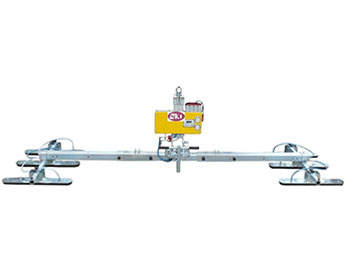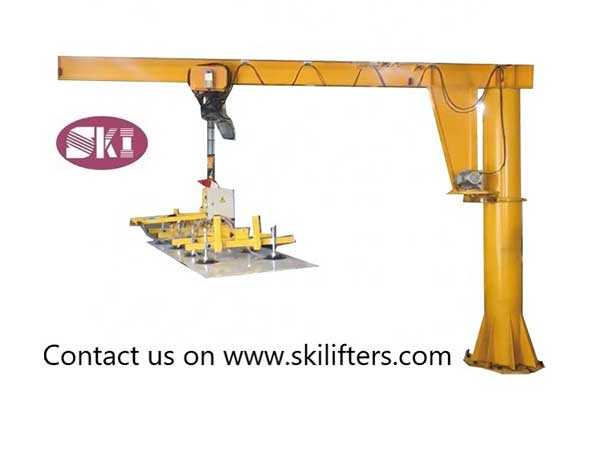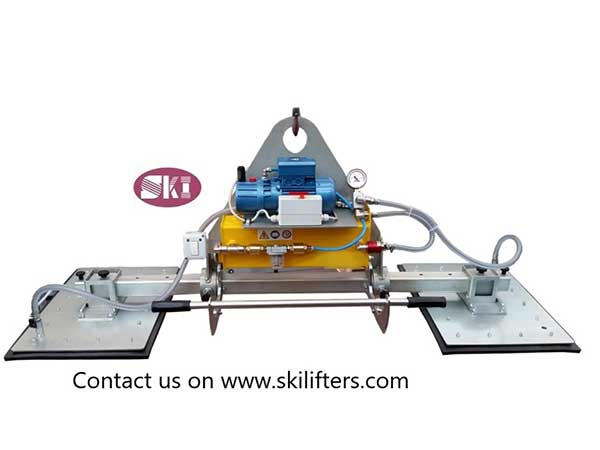Vacuum Lifters: The Future of Material Handling Solutions
Shree Krishna Industries is a leading vacuum lifter manufacturers, suppliers, and exporters in Qatar. As industries are changing at breakneck paces in a world that's rapidly turning computerised, the need for effective, safe, and automated material handling has increased in leaps and bounds. From building and transportation to production, and from storage to transportation, businesses are being pressed more than ever before to provide maximum productivity with minimum risk. In this transformation, one technology is leading the way: the vacuum lifter.
Vacuum lifters have arrived, changing the way business handles huge amounts of different kinds of material in a quiet revolution. Delicate glass doors to enormous slabs of concrete, vacuum lifters offer a safer, faster, and more ergonomic solution to lifting and moving things.
So, what is a vacuum lifter, then? How do they operate? Why are they stealing the spotlight in markets? And where is this technology headed? Let's take a deeper dive.
What is a Vacuum Lifter ?
A vacuum lifter is a vacuum technology (suction pressure) lifting equipment for picking, lifting, and transporting material. Vacuum lifters differ from mechanical hooks or clamps because they are made of suction cups or pads creating an enclosed space between the lifter and the surface of the material to be lifted. Vacuum lifters are thus best suited to lift non-porous, smooth material and, due to new technology, even porous material.
The most essential elements of a vacuum lifter are:
- Vacuum pump or generator: Creates the negative pressure needed for vacuum suction.
- Suction cups or pads: Close against the load and create an airtight seal.
- Frame or lifting beam: Bears the suction pads and is attached to the crane or hoist.
- Control system: Enables operators to raise, lower, and release the load.
- Safety sensors: Ensure the vacuum level is sufficient before lifting and during lifting.
- Vacuum lifters are available in different sizes and types, ranging from small vacuum lifters involving small-scale application to industrial-sized ones used in lifting tons of weight.
Working Principles of Vacuum Lifters
Vacuum lifters are so adaptable and safe because the working principle is a simple one. This is how one does it step by step:
- 1. Vacuum Generation The process is triggered by a vacuum generator, electric or pneumatic. The equipment generates a vacuum (vacuum or area of low pressure) within the suction pads.
- 2. Sealing and Suction When suction pads are brought into contact with the surface of an object, the vacuum withdraws air from between the object and pad, thus forming a sealed interface. Air pressure and pressure difference against the vacuum give firmness to the object to be gripped in place.
- 3. Lifting and Moving Once the suction is initiated, the object may be raised with a crane, hoist, or user-controlled robotic arm. The load will tip, rotate, or slide based on the system capacity.
- 4. Controlled Release The vacuum is discharged by the operator as the object has been placed by discharging the vacuum with a control switch or a valve. Air flows into the suction pad, and the seal is destroyed to facilitate the load down slowly.
- 5. Safety Mechanisms New vacuum lifters also feature pressure-sensing devices to alert operators when pressure drops below safe levels. Vacuum backup circuits are used by some of the most critical application systems to provide even greater security.
Advantages of Vacuum Lifters
Vacuum lifters' success is no fluke. Vacuum lifters possess a number of benefits that make them far preferable to conventional material handling techniques:
- Safety in the Workplace: Manual handling accounts for the most occupational injuries. Vacuum lifters remove the physical labour from staff and the risk of incorrect lifting techniques. Integrated safety features also control loads, averting accidents.
- Increased Productivity: Vacuum lifters simplify the lifting process by minimising loading and unloading times. Efficiency is translated into faster flows and increased throughput.
- Operating Cost Savings: By cutting down labour needs, minimising product damage, and achieving productivity to the maximum, vacuum lifters translate into cost-saving numbers in the long run. While initial capital can be costly, ROI in the long run is astronomical.
- Ergonomic Design: Ergonomics are indeed a requirement in the factory environment. Vacuum lifters minimise fatigue and muscle strain, enabling employees to work for hours without injury or unease.
- Adaptability and Customization: Vacuum lifters today are very versatile. For vacuum-sealed boxes, curved glass, or porous stone, arrangements of pads, size, and control methods can be tailored to construct systems.
Within a Broad Spectrum of Industries
There are many industries that use vacuum lifters to serve each to their advantage:
- Construction and Architecture Vacuum lifters are critical in the construction of buildings for fitting glass facades, windows, and panels. Vacuum lifters provide accurate fitting with no breakage or injury risk.
- Metal Fabrication and Sheet Handling Vacuum lifters facilitate the convenient handling of heavy, sharp-edged metal sheets and bring improved speed and safety in fabrication shops and metal warehouses.
- Stone and Ceramic Industries Marble, granite, and ceramics vacuum lifters safely move heavy, delicate slabs without destroying their edges or surface with ease.
- Logistics and Warehousing Vacuum lifters assist in moving boxes, barrels, bags, and drums to make loading and unloading tasks more convenient and secure in warehouses and distribution centres.
- Automotive and Aerospace Vacuum lifters are employed in such precise industries for part transportation like windshields, hoods, and panels without a scratch or mark.
- Pharmaceuticals and Food Clean vacuum systems handle food-grade material in clean rooms for packaged items, bottles, and boxes.
New Technological Innovations in Vacuum Lifters (2024–2025)
With businesses going digital, even vacuum lifters are evolving. Some of the latest technologies that are turning these systems smart and efficient are:
- IoT-Enabled Monitoring: Today’s vacuum lifters have onboard IoT (Internet of Things) capability. Vacuum pressure, utilisation, and equipment health are monitored by sensors, which are remotely monitored using cloud dashboards. Predictive maintenance can be done, and downtime is minimised.
- Battery-Powered and Cordless Systems: New lithium-ion battery technology has provided cordless and portable vacuum lifts. The lift can be used most effectively where power supply on site is poor. Battery lifts are less reliant on electric cables or compressed air and are also environmentally friendly.
- AI-Powered Control Systems: Artificial Intelligence is also utilised to optimise the lifting operations. AI systems have the ability to modify the vacuum power based on the material automatically or detect unbalanced ground and dynamically adjust the mode of lifting.
- Integration with Collaborative Robots (Cobots): Vacuum lifters are also being mounted on cobots (collaborative robots) to be utilised in helping human beings in collaborative environments. These installations are becoming the vogue in smart factories, where repetitive lifting, among others, is being mechanised.
- Adaptive Suction Pads: Emerging pad sucking technologies increasingly allow vacuum lifters to lift porous and non-regularly profiled materials like concrete, wood, or packaging. Flexible foams or adaptable pads best work when it comes to conforming to surface profiles.
Future Market Outlook (2025–2030)
The future market for vacuum lifters is best placed to witness phenomenal growth in the next two years on the back of industrialisation and automation trends.
- Market Growth Projection: Based on industry estimations, the overall vacuum lifters market globally will record more than 7% CAGR from 2025-2030. The market will exceed USD 2.5 billion by 2030 owing to augmenting demand for material handling technologies across industries.
- Geographical Trends
- Asia-Pacific:Both urbanization and industrialization are driving demand, and there is high activity in China, Qatar, and Southeast Asia.
- Europe: There is strong focus on worker safety and sustainability driving uptake.
- North America: e-commerce, logistics, and manufacturing automation are driving.
- Specialized Customization and Designs: Microelectronics vacuum-assisted lifters for retail logistics lighter handheld units, heavy-duty renewable energy and construction lifters, and vacuum robotic grippers more specialised lifters are to be expected.
Challenges to Be Overcome
Even though vacuum lifters have numerous benefits, there exist some challenges as well that need to be overcome:
- High Initial Costs: High-end Surface models with advanced technology features are expensive.
- Surface Issues: Till date, there are some surfaces that still prove to be a problem to be able to create an efficient vacuum seal.
- Maintenance Requirements: Maintenance needs to be carried out periodically to prevent failure of suction.
- Training Requirements: The operators will have to be trained for operating and maintaining the equipment optimally. But to a great extent, technological advancements and falling prices will eliminate such obstacles.
Conclusion: Looking Up to the Future
Shree Krishna Industries is a dominant vacuum lifter manufacturers, suppliers, and exporters in Qatar. Vacuum lifters are not equipment — they are smart, flexible systems engineered to fit the ever-growing needs of industry today. With technological advancements and better working conditions, vacuum lifters are increasingly vital tools for companies committed to safety, efficiency, and accuracy. From building construction to precise electronics production, vacuum lifters are leading the charge to a better, safer, more efficient future. If your company hasn't already discovered vacuum lifting systems, now is the time to take your material handling strategy to new heights.
The future of lifting isn't mechanical — it's intelligent, ergonomic, and vacuum-driven!




